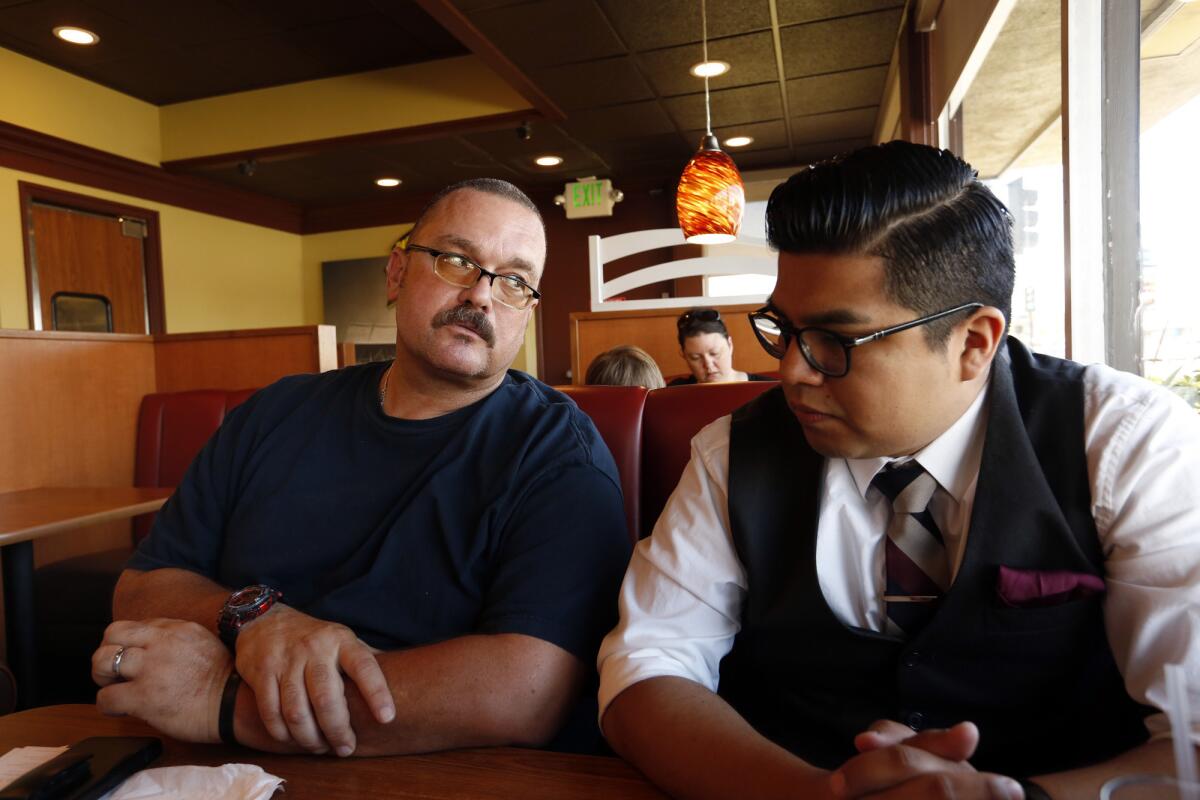He was homeless — but to get help, the rules said he had to prove it

After being discharged from detox, Rory Gallegos had nowhere to go. So he made the street his home.
A year later, he thought he had found a home when the Hillview Mental Health Center in Pacoima offered him an apartment with onsite mental health services.
But to qualify for a voucher to pay for the room, Gallegos first had to prove that he was chronically homeless. He couldn’t produce the necessary documents.
For another year, he languished in a bureaucratic holding pattern, living in a shelter to establish his homelessness, by definition, while Hillview kept his room on hold.
Gallegos was caught in a historic transition in housing policy as the federal government wrestled with how to parcel out inadequate resources to the most needy. It’s a shift away from waiting lists toward what is essentially a homelessness grading system.
Nearly three-fourths of Los Angeles County’s 50,000 homeless people live on the streets — and there are far too few vacant units to house more than a fraction of them.
To sort out the few who will receive housing from the many who are in need, a complex and sometimes confounding rule book has evolved. It defines chronic homelessness, sets standards for documenting it and rates every applicant on a competitive scale.
It’s a system that prizes equity and efficiency over the human touch.
::
Gallegos is one of more than 21,000 residents of Los Angeles County who have been entered in a database called the HMIS, or Homeless Management Information System.
Just over 1,100 of them had been placed in housing, and the list is growing faster than housing is being produced.
To get into the competition, every applicant must fill out the Vulnerability Index-Service Prioritization Decision Assistance Tool, known to case managers — few of whom are likely able to recite its name — as the VI-SPADAT.
It consists of 44 questions that probe the client’s physical and mental well-being and are designed, in clinical terms, to rate who is most likely to die on the street. They include:
“Have you threatened to or tried to harm yourself or anyone else in the last year?”
“Do you have planned activities, other than just surviving, that make you feel happy and fulfilled?”
Based on the answers, a caseworker fills in a score sheet. Everyone gets a number from 1 to 17.
Under a regime of federal and local housing policies shaped by the growing focus on homelessness, housing vouchers for a program like Hillview’s are given first to those with the highest scores.
Simply being homeless is not enough to get a high score. An applicant must have been homeless at least one year, or four times over a three-year period, and have an impairment such as mental illness or drug or alcohol addiction that would diminish the potential for living independently.
::
When Gallegos became a Hillview client in 2013, he didn’t have to compete. Hillview had a contract with the L.A. County Department of Mental Health to use a new federal voucher program called Shelter Plus Care in its 75-unit Village apartments. It kept a waiting list of clients who would receive vouchers as rooms became available.
Gallegos was on the list and getting near the top.
The waiting list system worked for Hillview. It allowed the agency to provide housing for its own clients who would benefit from the 24-hour availability of a case manager and mental health services.
But it didn’t work smoothly everywhere.
Raymond Fuentes, placement manager for the Skid Row Housing Trust, faced a nightmare every time he opened the waiting list at one of the agency’s downtown projects.
“You say you’re going to open a wait list. That translates into, ‘This guy’s giving out Section 8 vouchers to the first 10 people,’ ” Fuentes said, adding that hundreds of people would gather. “It created a lot of chaos.”
The lists were first-come, first-served, so applicants fought for a place in line.
“People would do anything they could to get in the front of the line,” Fuentes said.
Those who needed the housing most often were the least competitive, or didn’t even bother getting in line.
::
By 2014, change was on the way. Congress had established “housing first” as federal policy. The Department of Housing and Urban Development made it clear that local agencies using homeless housing funds would have to develop detailed criteria for ranking applicants.
“It is a fundamental shift,” said Ann Marie Oliva, HUD’s deputy assistant secretary for special needs. “Instead of having individual providers decide who will be served by programs, communities will create standards that will determine who is served. That can be a tough thing for local providers to do, and it’s taking some time.”
Homeless advocates in Los Angeles designed a system called coordinated entry to decide who would receive permanent housing.
The new rules, rolled out in the fall of 2014, invalidated Hillview’s waiting list, putting Gallegos into the mix with everyone in the database.
::
In theory, Gallegos competed well. A back injury sidelined his employment as a laborer. He’d been diagnosed with mental illness (he declined to specify exactly what).
“Having mental illness is bad,” he said. “You add addiction … ”
He tried to check into the Tarzana Treatment Center, but Medi-Cal wouldn’t cover it, he said. He was referred to Redgate Memorial Recovery Center in Long Beach for detox.
On the 14th day, he was released and made his way to 130th and San Pedro streets, he said. He stayed there for the next year.
To see his therapist, he’d take the Green Line to the Blue Line to the Red Line, and at the North Hollywood Station, he’d catch the 224 bus to the 233 bus to Pacoima.
But his history turned out to be irrelevant when a caseworker took Gallegos to the city Housing Authority on Wilshire Boulevard to apply for his voucher. The new rules were in effect, and Gallegos hadn’t been put into the database.
Axel Cortes, Hillview’s housing coordinator, entered him into the database in October 2014 and accompanied him downtown to reapply.
He was rejected again. HUD rules required third-party verification of homelessness with beginning and ending dates. The letters Cortes brought from a food bank didn’t specify dates.
“I said, ‘He is homeless,’ ” Cortes said. “They said, ‘It has to be the dates.’ ”
Cortes said he got the food bank to redraft the letter with dates, but it took out the word “homeless” because the agency couldn’t vouch that Gallegos actually was homeless the entire time he received aid.
The new letter failed to sway the intake worker at the Housing Authority.
“The lady was saying this letter needs more specific information,” Cortes said. “I was explaining this is the best it’s going to get.”
“I got shot down again,” Gallegos said, a note of despair in his voice.
That’s when Cortes referred Gallegos to the shelter run by L.A. Family Housing in a converted motel, where up to 250 men and women were housed, three or four to a room.
In that environment, it was hard to avoid drugs and alcohol, Gallegos said. He had relapses, but says he has now been sober for months.
“I was really happy he persevered and kept strong,” said Cortes, who since has left Hillview to go back to college, saying the work was emotionally draining. “There are other clients who don’t have that strength. There are times I don’t know if I will see the client again.”
After nine months, Gallegos finally was certified as being chronically homeless. By then, though, he had soured on living amid other homeless people.
“On the third try, I decided I want my own apartment,” he said.
After two months of futile searching for a vacancy that would accept his personal Section 8 voucher, Gallegos was fed up with shelter life. He prevailed on a friend he met in recovery to let him move in with her.
He’s still looking for his own apartment. The only openings he has found are in the one place he won’t go: the old neighborhood where his troubles began.
“I want to move forward with my life, not back,” Gallegos said.
But he’s becoming demoralized. His voucher expires soon. He may try to work out a permanent arrangement with his friend.
“I think I’m good where I am,” he said.
ALSO
Without a parachute, sky diver plummets into net from 25,000 feet
Squeezed garment factories use check cashing services to mask true wages, workers say
It’s billionaire versus billionaire as Mark Cuban targets Donald Trump for Hillary Clinton
More to Read
Sign up for Essential California
The most important California stories and recommendations in your inbox every morning.
You may occasionally receive promotional content from the Los Angeles Times.











